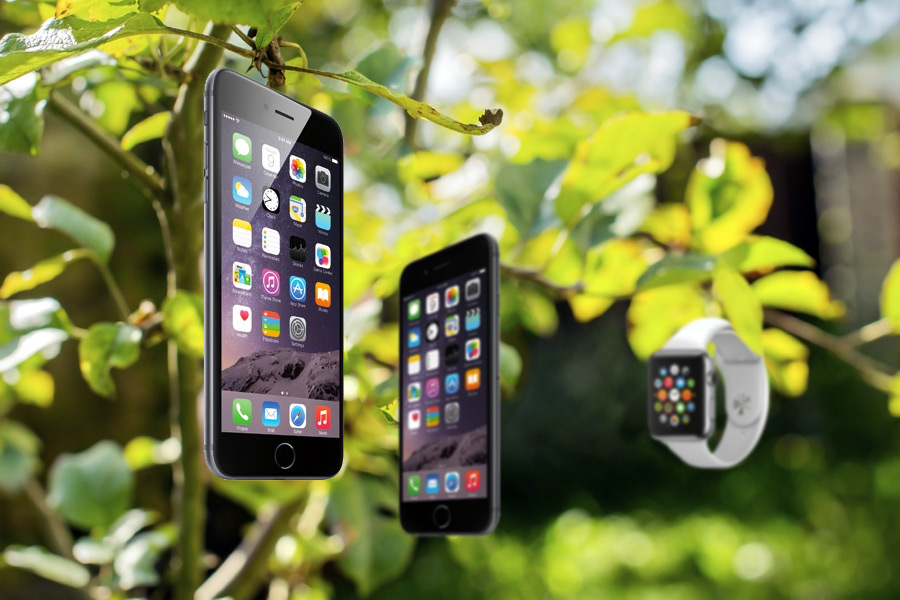East End Tech: It’s Apple Season and iPhone 6 Is Ripe for the Picking

Apple’s big announcement has finally happened, and we’ve got the details on the brand new iPhone 6 and 6 Plus. “Weighing in” at 4.7 and 5.5 inches respectively, Apple has somehow managed to expand on their features in nearly every way while actually making them thinner than the already ludicrously thin 5/5c/5s family. On top of the new iPhone, Apple will also be rolling out their long-awaited wearable, Apple Watch.
The iPhone 6 features the usual upgrades to the iPhone line—an upgraded A8 chip and motion coprocessor which should eke out a bit more battery life despite the larger screen, more LTE bands, allowing for much faster 4G download speeds, and wireless AC functionality, giving you three times more Wi-Fi bandwidth. Apple is claiming the battery will last up to 10 hours on the 6, and 12 hours on the 6 Plus, during LTE browsing, which is a huge improvement over whatever my humble iPhone 5 can do lately.
The 6 also features NFC technology, allowing you to pay with your phone. NFC technology has been available on select Android phones for a few years now, but with Apple’s entry into the market, I would imagine more places will jump on board and start accepting it as payment. Apple’s NFC technology relies on the TouchID fingerprint system, adding another level of security.
Possibly the biggest deal with the iPhone 6 is the huge improvement in the camera. The camera itself is getting a physical upgrade, slightly increasing the number of megapixels, but a lot of the improvements aren’t strictly related to that. The new camera will feature more video capabilities, including 60-frames-per-second full HD video, continuous autofocus, video stabilization, and seriously impressive time lapse and 240 frames per second slow motion capability. There’s also improved face detection and burst mode, which takes a “burst” of 10 photos and chooses the best one for you, looking for sharpness, clarity, and also checking whether people are blinking! Pretty useful, judging from my photo gallery.
But the iPhone’s moment was stolen by the introduction of the Apple Watch. Available in three models (the stainless steel Watch, the aluminum Watch Sport, and the 18k gold Watch Edition) and two sizes (38 and 42mm), the Apple Watch features the sleek design you’ve come to expect from Jony Ives. The Watch is controlled through both the touchscreen and the “digital crown,” the dial on the side that functions as a scroll/zoom dial as well as the home button. The screen of the watch (a hunk of polished sapphire crystal on the Watch and Watch Edition versions) is not only a traditional touchscreen, but also is able to sense the force—it can distinguish between a tap and a press, and can even detect how hard you’re pressing.
Tying into the launch of the iOS Healthkit, the Apple Watch has an accelerometer that keeps track of your total movement, a heart-rate monitor, and uses GPS and Wi-Fi to judge how far you’ve walked during the day. All of this is presented in an easy-to-read graph, and the software helps you set realistic fitness goals, awarding you with achievements for making them.
On top of the fitness stuff, the Apple Watch does many of things that you’d expect from a smart watch—access your calendar, control your music, use it (obviously) as a watch, check the weather, stocks, timer, etc. But there are some unique features that set it apart from the competition—you can use it as a remote for your Apple TV or iTunes, a remote camera control for your iPhone, and for NFC payments with Passbook and Apple Pay. There’s also digital touch communication, allowing you to send little sketches or taps with your friends who also have Apple Watches, or even send them your heartbeat (which seems like it could be either very cute or very creepy, depending on context).
The Apple Watch will start at $349, depending on options.









